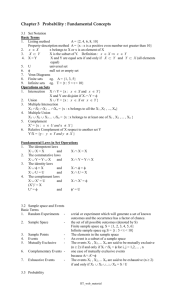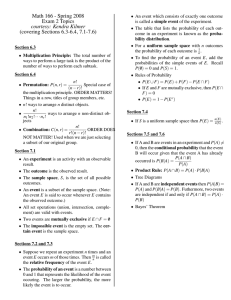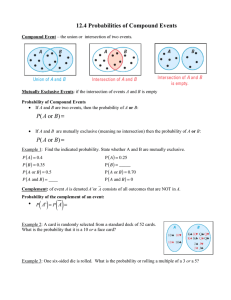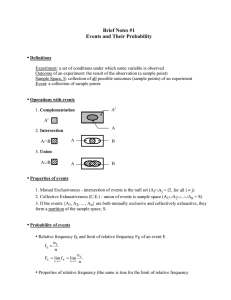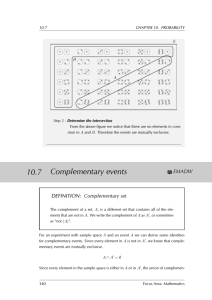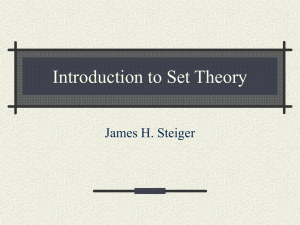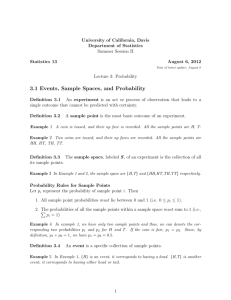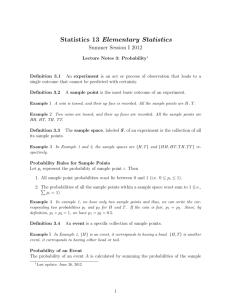Basics of Set Theory Symbols, Operations and Properties Poli Sci
advertisement
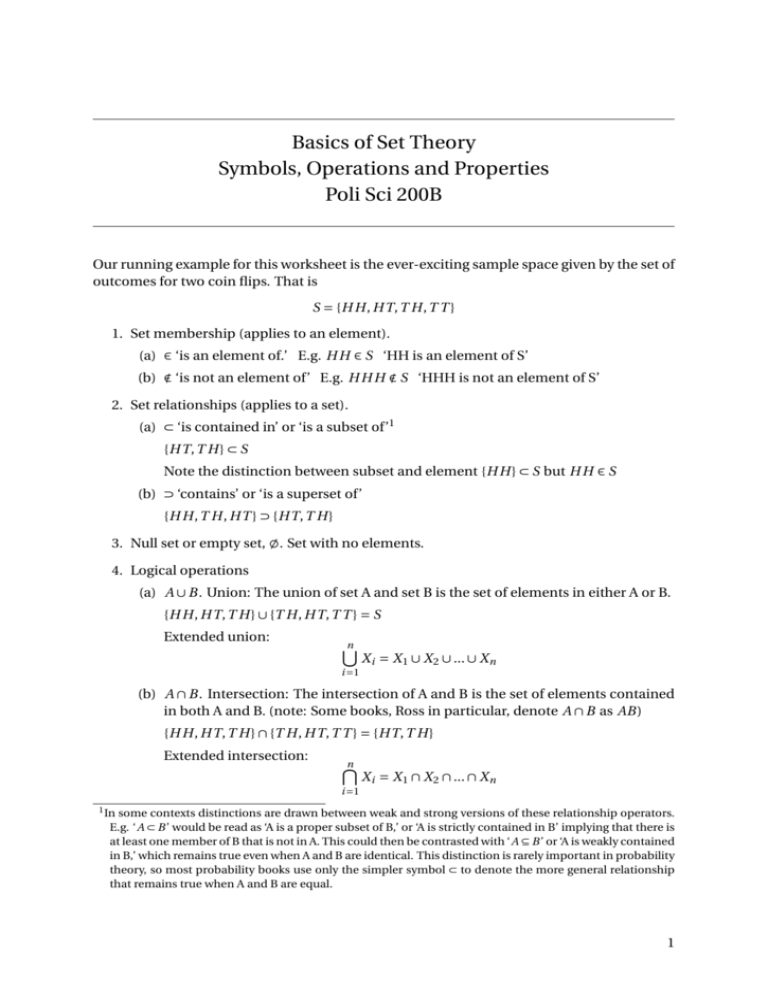
Basics of Set Theory
Symbols, Operations and Properties
Poli Sci 200B
Our running example for this worksheet is the ever-exciting sample space given by the set of
outcomes for two coin flips. That is
S = {H H , H T, T H , T T }
1. Set membership (applies to an element).
(a) ∈ ‘is an element of.’ E.g. H H ∈ S ‘HH is an element of S’
(b) ∉ ‘is not an element of’ E.g. H H H ∉ S ‘HHH is not an element of S’
2. Set relationships (applies to a set).
(a) ⊂ ‘is contained in’ or ‘is a subset of’1
{H T, T H } ⊂ S
Note the distinction between subset and element {H H } ⊂ S but H H ∈ S
(b) ⊃ ‘contains’ or ‘is a superset of’
{H H , T H , H T } ⊃ {H T, T H }
3. Null set or empty set, ;. Set with no elements.
4. Logical operations
(a) A ∪ B . Union: The union of set A and set B is the set of elements in either A or B.
{H H , H T, T H } ∪ {T H , H T, T T } = S
Extended union:
n
∪
i =1
X i = X 1 ∪ X 2 ∪ ... ∪ X n
(b) A ∩ B . Intersection: The intersection of A and B is the set of elements contained
in both A and B. (note: Some books, Ross in particular, denote A ∩ B as AB )
{H H , H T, T H } ∩ {T H , H T, T T } = {H T, T H }
Extended intersection:
n
∩
i =1
1
X i = X 1 ∩ X 2 ∩ ... ∩ X n
In some contexts distinctions are drawn between weak and strong versions of these relationship operators.
E.g. ‘A ⊂ B ’ would be read as ‘A is a proper subset of B,’ or ‘A is strictly contained in B’ implying that there is
at least one member of B that is not in A. This could then be contrasted with ‘A ⊆ B ’ or ‘A is weakly contained
in B,’ which remains true even when A and B are identical. This distinction is rarely important in probability
theory, so most probability books use only the simpler symbol ⊂ to denote the more general relationship
that remains true when A and B are equal.
1
(c) Complement. ∼ A or A c : The complement of set A is everything in the universal
set S (the sample space, in our context) that is not in A.
∼ {H H , H T, T T } = {T H }
Note:
∼ A∪A=S
∼ A∩A=;
5. Algebraic rules
(a) Commutative Laws
A ∪ B ⇔ B ∪ A and A ∩ B ⇔ B ∩ A
(b) Associative Laws
(A ∪ B ) ∪ C ⇔ A ∪ (B ∪ C )
(A ∩ B ) ∩ C ⇔ A ∩ (B ∩ C )
(c) Distributive Laws
(A ∪ B ) ∩ C ⇔ (A ∩ C ) ∪ (B ∩C )
(A ∩ B ) ∪ C ⇔ (A ∪ C ) ∩ (B ∪C )
(d) Demorgan’s Laws
∼ (A ∪ B ) =∼ A ∩ ∼ B
∼ (A ∩ B ) =∼ A ∪ ∼ B
6. Additional terms and ideas
(a) Mutually exclusive sets
They have an empty intersection. If A i ∩ A j = ;, for all i , j , then {A 1 , A 2 , ...A n } are
mutually exclusive.
(b) Partition
A partition divides a set into a set of mutually exclusive and exhaustive subsets.
∪
If A i ∩ A j = ;, for all i , j and ni=1 A i = B , then {A 1 , A 2 , ...A n } are a partition of B.
(c) A ‘divide and conquer’ rule for sets.
Any set can be broken down into the part of it that intersects with another set
and the part that does not. That is,
A = (A ∩ B ) ∪ (A ∩ ∼ B )
2

